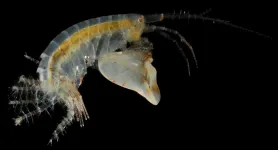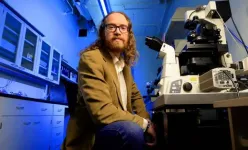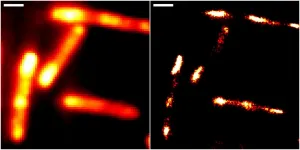Tiny crustaceans' show fastest repeatable movements ever seen in marine animals
New research shows that amphipod claws make snapping movements at 100 kilometres per hour and can accelerate nearly as fast as a bullet.
2021-02-25
(Press-News.org) A group of crustaceans called amphipods can accelerate as fast as a bullet--literally, according to a new study by biologists at the University of Alberta and Duke University.
This study shows that a tiny and unusual species is responsible for making the fastest repeatable movements yet known for any animal in water.
"The high speeds of these repeatable movements reach nearly 30 metres per second or more than 100 kilometres per hour," explained Richard Palmer, professor emeritus in the Department of Biological Sciences and co-author on the study.
"They have the highest accelerations of any animal in water, reaching more than 0.5 million metres per second squared, which is close to the acceleration of a bullet."
A high-speed video camera captures footage of an amphipod's claw snapping at 300,000 frames per second. (Video: Sheila Patek, Duke University)
Amphipods are a type of crustacean related to marine beach hoppers and freshwater scuds. Male amphipods use their large claws to make ultra-fast, repeatable snapping motions. The snaps make a popping sound and create rapid water jets that may be used to defend their territory.
"Each new discovery of extreme movements in a novel group of organisms raises fascinating questions about how such extreme adaptations are achieved in terms of biomechanics and functional behaviour, and how they evolved from more common, slower-moving relatives," said Palmer.
Though faster movements have been seen in other creatures, these movements only happen once and cannot be repeated. As Palmer noted, the mechanism that allows amphipods to create such high-speed movements repeatedly could inspire human engineering efforts.
"This may suggest novel engineering solutions to design and build small structures that can move extremely fast over and over."
INFORMATION:
This research was led by Sarah Longo and Sheila Patek at Duke University, in collaboration with Palmer in the U of A's Faculty of Science. Funding was provided by the Natural Sciences and Engineering Research Council of Canada.
The study, "Tiny snaps of an amphipod push the boundary of ultrafast, repeatable movement," was published in Current Biology.
[Attachments] See images for this press release:

ELSE PRESS RELEASES FROM THIS DATE:
2021-02-25
Glycomics researchers at the University of Alberta and CHU Sainte-Justine have reported a discovery that could lead to new treatments for cardiovascular disease.
The researchers identified a new mechanism responsible for the buildup of plaque on artery walls, a process known as atherosclerosis. This plaque, made up of fats, cholesterol and other substances, can restrict blood flow and is a major factor in cardiovascular disease.
"We identified a new mechanism underlying atherosclerosis," explained Chris Cairo, professor in the Department of Chemistry and co-lead author of the new study. "We also demonstrated that this can be addressed pharmacologically. Using inhibitors ...
2021-02-25
Key takeaways
Opioid prescribing guideline is unique, taking into account each patient's perception of pain, rather than prescribing opioids based on type of operation.
Surgeons play a pivotal role in minimizing opioid use in their patients by setting expectations for pain management.
Opioid disposal rates dramatically increased because surgeons told patients about specific FDA-compliant methods for pill disposal, the location of a convenient pharmacy drop box, and made a reminder phone call.
CHICAGO (February 25, 2021): A prescribing guideline tailored to patients' specific needs reduced the number of opioid pills prescribed after major surgery with researchers reporting ...
2021-02-25
Spring snowmelt in the Alps is occurring earlier in the year due to climate change and as a result triggering abrupt deviations in mountain ecosystems. These changes could negatively affect the functioning of these valuable ecosystems.
New research has demonstrated that vitally important microbial communities within Alpine soils are under threat as a direct result of increasing global temperatures caused by ongoing climate change. These belowground microbes critically support aboveground life because they recycle the key nutrients upon which all animals and plants depend, ...
2021-02-25
Smartphones could be used to scan people's eyes for early-warning signs of glaucoma - helping to prevent severe ocular diseases and blindness, a new study reveals.
Some of the most common eye-related diseases are avoidable and display strong risk factors before onset, but it is much harder to pinpoint a group of people at risk from glaucoma.
Glaucoma is associated with elevated levels of intraocular pressure (IOP) and an accurate, non-invasive way of monitoring an individual's IOP over an extended period would help to significantly increase their chances of maintaining their vision.
Soundwaves used as a mobile measurement method would detect increasing values of ...
2021-02-25
A safe, fast and cheap testing method that uses magnetic nanoparticles to detect viruses in both clinical and wastewater samples has been developed by KAUST researchers. The centrifuge-free approach is compatible with magnetic bead-based automated systems that are already used to process hundreds of samples.
"Our silica magnetic nanoparticle-based workflow can be assembled from scratch by any researcher," says lead author Gerardo Ramos-Mandujano. "It rivals commercial viral-RNA extraction kits while lowering the risk of handling potentially infectious samples."
To diagnose COVID-19, clinicians extract SARS-CoV-2 viral RNA from different types of clinical samples, such as nasopharyngeal swabs, and detect the virus using ...
2021-02-25
Air pollution from fuel combustion is one of the greatest environmental problems, especially in urban environments. In densely populated cities, the presence of nitrogen oxides, very small carbon particles, and carbon monoxide (CO) in the air seriously harms the human health and increases mortality. A collaboration between researchers from the University of Barcelona and from the Boreskov Institute of Catalysis of the Russian Academy of Sciences in Novosibirsk (Russia) opens the way for reducing emissions of automotive pollutants. In a recent study, the scientists ...
2021-02-25
Ribonucleic acid (RNA) is key to various fundamental biological processes. It transfers genetic information, translates it into proteins or supports gene regulation. To achieve a more detailed understanding of the precise functions it performs, researchers based at Heidelberg University and at the Karlsruhe Institute of Technology (KIT) have devised a new fluorescence imaging method which enables live-cell RNA imaging with unprecedented resolution.
The method is based on a novel molecular marker called Rhodamine-Binding Aptamer for Super-Resolution Imaging Techniques (RhoBAST). This RNA-based fluorescence marker is used in combination with the dye rhodamine. Due to their distinctive properties, marker and dye interact in a very specific way, which makes individual RNA molecules ...
2021-02-25
Similar to the fact that a person would act differently when being alone, materials can also obtain unique qualities when being separated in atom-level, among which is the enhanced catalyzing ability.
Single-atom catalysts have shown enormous catalyzing capability since its first appearance. By preparing 2-dimensional (2D) single-atom monolayer crystals, scientists can expect to get catalysts with high loading density of active sites as well as great stability. However, the question herein is that only the edge atoms in the 2D monolayer have shown this effect while most of the atoms are inside the basal plane, which is critically limiting the efficiency ...
2021-02-25
One of the main culprits of global warming is the vast amount of carbon dioxide pumped out into the atmosphere mostly from burning fossil fuels and the production of steel and cement. In response, scientists have been trying out a process that can sequester waste carbon dioxide, transporting it into a storage site, and then depositing it at a place where it cannot enter the atmosphere.
The problem is that capturing carbon from power plants and industrial emissions isn't very cost-effective. The main reason is that waste carbon dioxide isn't emitted pure, but is mixed with nitrogen and other gases, and extracting it from industrial emissions ...
2021-02-25
NUI Galway study finds problem and non-problem gamblers differ in the gratifications they seek from mobile gambling
Non problematic mobile gambling is associated with positive mood
Advice for regulators and mobile gamblers on how to avoid gambling harms
A study carried out by the J.E. Cairnes School of Business and Economics at NUI Galway has examined how the different gratifications sought from mobile gambling explain problematic versus non-problematic patterns in highly involved gamblers.
For a subgroup of vulnerable individuals, gambling involvement can be pathological and reflects a personality disorder. ...
LAST 30 PRESS RELEASES:
[Press-News.org] Tiny crustaceans' show fastest repeatable movements ever seen in marine animals
New research shows that amphipod claws make snapping movements at 100 kilometres per hour and can accelerate nearly as fast as a bullet.






